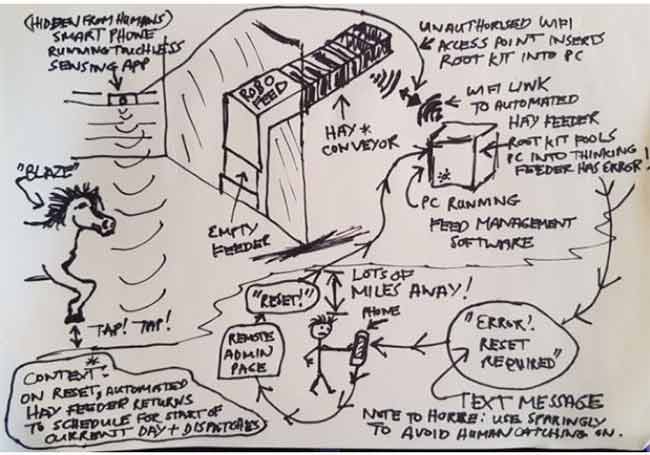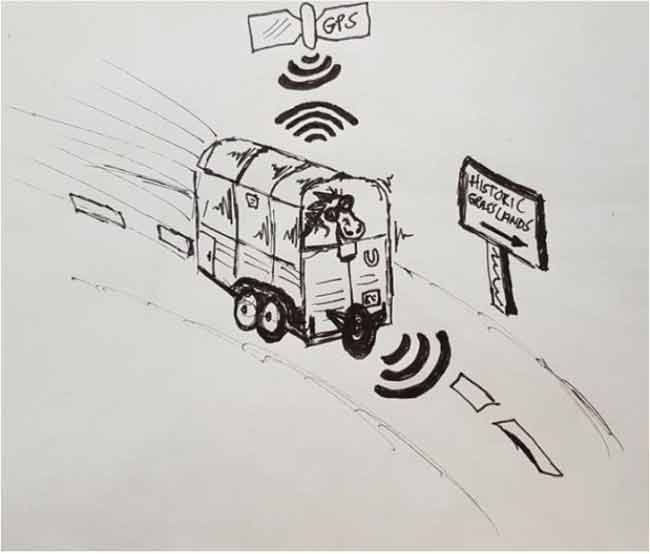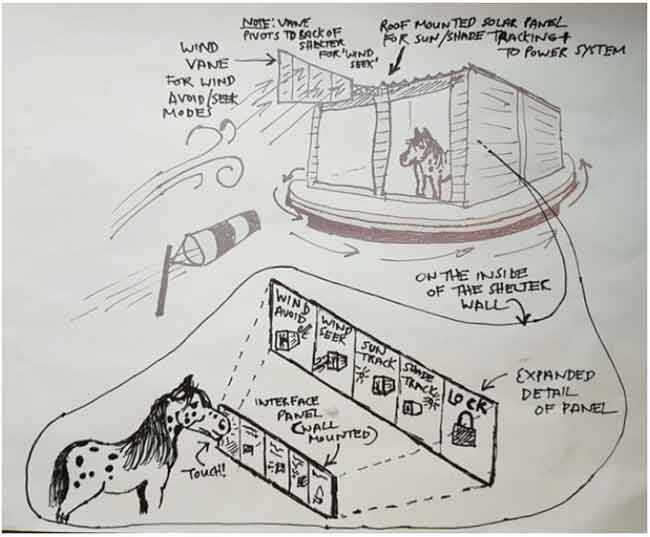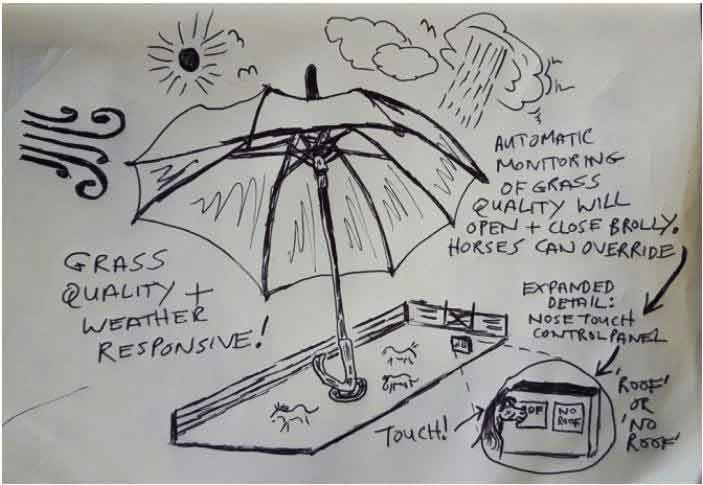Steve North
EASE
(Exeter Anthrozoology as Symbiotic Ethics) working group
University of Exeter, UK
[email protected]
ABSTRACT
Horses (and other nonhuman animals) are increasingly encountering systems designed by human animals. Some of these systems are conceived with altruistic motives to enrich horses’ lives. Other systems are designed to facilitate human interaction, with little consideration for the animals forced to share the human environment. As with cognitively challenged humans, horses are ‘unaware’ and often ‘implicit’ interactors. This category of user is uniquely vulnerable to the projected requirements and needs of designers. To think like a horse (or any user without a voice) a designer must be able to embrace ‘the otherness’ of an unfamiliar perspective. This paper uses four examples of ‘design fiction’ to speculate about systems that might actually be meaningful to a horse. The intention is not to seriously propose these as prototypes. Rather, they are thought experiments, illustrating the inherent danger in trying to co-design with the voiceless.
Author Keywords
animal-computer interaction; horse-computer interaction; design fiction; speculative design; prototyping; user- centered design
ACM Classification Keywords
H.5.m. Information interfaces and presentation (e.g., HCI): Miscellaneous; H.5.2. Information interfaces and presentation (e.g., HCI): User Interfaces – Evaluation/methodology; Prototyping; Theory and methods; User-centered design;
INTRODUCTION
The purpose of this paper is to help system designers to understand just “how difficult it is to figure out what animals are up to” [3]. Horse-computer interaction has previously been discussed as a theme [12] and the same
Permission to make digital or hard copies of part or all of this work for personal or classroom use is granted without fee provided that copies are not made or distributed for profit or commercial advantage and that copies bear this notice and the full citation on the first page. Copyrights for third- party components of this work must be honored. For all other uses, contact the Owner/Author.
ACI2017, November 21–23, 2017, Milton Keynes, United Kingdom
© 2017 Copyright is held by the owner/author(s). ACM ISBN 978-1-4503-5364-9/17/11.
https://doi.org/10.1145/3152130.3152149
species will provide a focus for this paper. Rather than attempting to actually design real world systems for the horse, it is intended to help the reader consider how incredibly ‘other’ the mind of a non-human animal might seem.
Animal-Computer Interaction (ACI) [11,14] is a young field, but researchers already face some challenging questions. For example, what does user-centered design / co-design look like for non-human animals? Could this even be achieved? There is no obvious roadmap, but there is a need to start taking incremental steps. Whilst the route to ‘honest’ user-centered design for non-human animals may still be opaque, it is easier to identify the pitfalls to avoid. Primarily, it is essential that we avoid ‘dishonestly’ projecting our own design goals and intentions onto the animal.
Horses have systems designed specifically for them. They are also sometimes co-users of systems designed specifically to benefit human animals. Even when systems are supposedly designed for the horse, one has to question the underlying motivations. Is this really something that the horse would ask for him or herself, or is the ultimate beneficiary the human?
Human animals are now technically able to monitor horses for pain, stress, relaxation, and behavioural abnormality. However, it is arguable that such technology is only developed in order to improve the horse’s sporting performance and utility to the human. There are also computer-controlled group housing systems such as the commercially available Active (or Aktiv) Stable [5, 6]. Such systems are even modeled in the virtual world of Minecraft [8].
On the following pages, the established HCI technique of speculative design / design fictions [15,2,10] is used to illustrate four system designs that might prove meaningful to a horse. Lawson et al. have previously described speculative design in ACI, when applied to dogs and their use of the internet [9]. In the following sections, inspired by ‘Cholla the painting horse’ [1], our fictional co-researcher / horse (‘Blaze’) has agreed to illustrate his four design suggestions with his ‘horse-drawn’ sketches…

Figure 1. Horse-drawn sketch for “Hey, where’s my hay?”: hacking the Aktiv Stable
DESIGN FICTION #1 – “HEY, WHERE’S MY HAY?”: HACKING THE AKTIV STABLE
In the Aktiv Stable housing environment, horses may have limited daily allowances of fodder (hay or haylage). The automatic ‘robo feed’ machine is controlled by a WiFi connected computer, running feed management software. Individual horses are identified by an RFID chip, clipped to the mane hair. The system will deliver small, regular amounts of fodder to the horse (via a conveyor belt system), up to the daily limit prescribed for the current horse. In the event of a feed system error, the computer will send a text message to a human administrator. To ensure that horses are not being deprived of feed, the operator can log into the feed management computer and trigger a reset command. The (fictional) weakness in the system is that (on reset) the feed system will reset the daily allowances of fodder for all horses. Fictional horse Blaze lives in this Aktiv Stable system. He is proposing a speculative ‘hack’. This would allow him to gain remote access to the feed management software, generating a fake system error (see Figure 1). As Blaze is clever enough to realise that overusing this feature might attract unwanted human oversight, he requires a horse-computer interface, allowing periodic generation of system errors. When he taps his hoof in a specific sequence, Blaze wants a smartphone hidden somewhere in the stable wall to detect his gesture, using touchless sensing technology. This phone would have a wide-angle camera, a depth sensing camera and accurate sensor timestamping – as used in Google’s Project Tango [4]. The smartphone will then create an unauthorized WiFi access point. On first use, it will remotely install a root kit on the feed management PC. On subsequent triggering, the root kit will cause the feed management software to believe that an error has been sent wirelessly by the Robo Feed machine. The human user will then receive a text and (s)he is likely to send a reset command to the Robo Feed machine, via the feeder system’s remote management console. The result is that the daily fodder allowances for all horses are reset and they can all happily tuck into extra hay.

Figure 2. Horse-drawn sketch for Self-carriage: the autonomous driving horse trailer
DESIGN FICTION #2 – SELF-CARRIAGE: THE AUTONOMOUS DRIVING HORSE TRAILER
Self-carriage (note: this name is a joke, as it has a different meaning for equitation scientists!) is a conveyance for horse-pleasing excursions. Blaze tells us that he would like to visit previous herd members and sites of special equine interest (historic grasslands, national parks etc.). Without a driving license, he would like a system designed that would allow him climb into a self-driving trailer, transporting him automatically to his destination.
The speculative self-carriage design (see Figure 2) has been adapted from a traditional UK horse trailer design, usually towed by a car. A fifth wheel has been fitted to the front of the trailer. This vehicle is imagined to comply with Level 4 of the US National Highway Traffic Safety Administration (NHTSA) formal classification system [17]. That is to say that the Self-carriage will perform all safety-critical functions for the entire journey, with the horse not controlling the vehicle at any time (including stop/start, parking etc.).
The technology would be similar to many existing autonomous cars. Lidar (a laser range finder) would use an array of beams to create 3D images of objects within a 200m range. A front-mounted camera would ‘see’ objects immediately ahead of the trailer. In addition, front and rear radars would ensure a safe distance between the vehicle and other road users. An aerial mounted on the trailer’s roof (disguised as a curved cross-member) would provide very accurate positioning information. This would feed into the sat-nav, used for route planning. There is an interface touchscreen on an inside wall of the trailer. This allows the horse to select a destination from a scrollable, zoomable map. The horse’s nose is used to navigate the map and to select the destination.

Figure 3. Horse-drawn sketch for “Backs to the wind, boys”: a weather-responsive shelter for the British climate
DESIGN FICTION #3 – “BACKS TO THE WIND, BOYS”: A WEATHER-RESPONSIVE SHELTER FOR THE BRITISH CLIMATE
Horses are very sensitive to the weather. Blaze and his herd have free access to a field shelter building. Conventionally, field shelters are placed in a fixed location, optimizing the known weather conditions for the site. Usually, the shelter is positioned with its doorways away from the prevailing wind. Blaze wonders if technology might be able to improve this situation. He would like a shelter on a revolving pedestal, which can be moved either by a motor, or allowed to freewheel (see Figure 3). He has heard that similar summer houses have been built for humans. Usually these have been rotated manually. The shelter will have five modes (Wind Avoid, Wind Seek, Sun Track, Shade Track and Lock), controlled by a nose-touch interface panel, sited inside the shelter. The power is provided by the solar panels and a battery bank. A wind vane is fitted. This usually protrudes from the front of the shelter for Wind Avoid mode. Operating in a similar manner to an electricity- generating wind turbine, the vane (in conjunction with the freewheeling pedestal) will ensure that the shelter doorways are facing away from the wind direction. For Wind Seek mode, the vane will automatically rotate (via a centre pivot point on the roof) to the rear of the shelter. Now the shelter doorways will face into the wind. In Sun Track mode, the solar panels (mounted towards the front / door-side of the shelter) will allow the shelter to responsively rotate (using motor power), until maximum sunlight is detected. Shade Track mode does exactly the opposite to Sun Track. The solar panel is used to optimize minimum sunlight at the front of the shelter. Lock mode, allows a pleasing vista to be retained, turbulence to be avoided for nervous horses or stability for horses to embark and disembark.

Figure 4. Horse-drawn sketch for Sky Brella: a roof on the world
DESIGN FICTION #4 – SKY BRELLA: A ROOF ON THE WORLD
As suggested in Fiction #3, horses spend a great deal of time responding to the weather. When it is cold and windy, horses like to avoid the wind (without human-constructed shelter, they would turn their backs into it). However, when it’s very warm, horses might want to seek a cooling breeze. In a similar manner, horses would like some sun to warm them on a cold day. In summer, they need to avoid the sun and seek shade.
In Sky Brella (see Figure 4), Blaze would like to see a weather responsive shelter that allows the herd to stay outside, moving (which is essential for good equine health) and grazing. This system would be completely automatic, but it would also allow for manual intervention, via a horse- computer interaction touch panel. This would be mounted somewhere in the field, inside a robust housing (which would need to be resistant to use as a scratching post, by the less tech-savvy members of the herd – Blaze is an ‘early adopter’).
The shelter resembles a giant umbrella and it would automatically open and close, in response to both the weather and the quality of the grass. Therefore, a network of sensors would be required to measure grass colour, height, moisture content etc.. In addition, sun and rain sensors would allow the system to balance: sun, shade, wind protection etc., optimizing an environmental suitable to maintain equine homeostasis. The mechanism of Sky Brella would allow for intermediate positions, between fully open and fully closed. Therefore, it is possible to create regions of the field that are shaded (or protected from rain) during less severe weather events.
The touch panel offers two simple modes: ‘Roof’ or ‘No Roof’, allowing the automated mode to be overridden. Following the expiration of a one hour timer, automatic operation kicks back in the next time that an environmental change requires a system response.
DISCUSSION & CONCLUSION
Over the previous pages, the author (with Blaze’s assistance) has presented four examples of design fiction, which are speculatively proposed as being of interest to horses. Of course, the intention is not to present Blaze’s designs as serious reflections of equine requirement (after all, he may be a fictional steed, but he is also a realistic one). Instead, this is a thought experiment undertaken to reveal quite how strange the priorities of a horse might appear to a human-animal.
As an exercise, the use of design fictions in ACI may help the human animal to consider the non-human’s underlying motivations. A good starting point for putting oneself in the place of a non-human is to understand his or her ‘ethology’. That is to say a species’ normal repertoire of behaviors, as displayed under natural conditions and shaped by evolutionary pressures. Therefore, it is useful for a designer to make him or herself aware of a non-human’s typical behaviors, as reflections of their underlying motivations. This provides a framework to begin hypothesizing the non- human partner’s contribution to any process of co-design.
In addition to the species-level behavioural repertoire, there is also the desire of each individual for freedom from discomfort, anxiety and pain. The UK Government’s Animal Welfare Act 2006 [16] enshrines ‘five needs’ that animals are entitled to expect from their human guardians. These are:
- Need for a suitable environment
- Need for a suitable diet
- Need to be able to exhibit normal behaviour patterns
- Need it has to be housed with, or apart from, other animals
- Need to be protected from pain, suffering, injury and
Any designer considering both the ethology of the species and the five needs is well on the way to giving animals a ‘voice’. The lessons learned (1. applying design fictions to enhance understanding of the ‘voiceless’ and 2. avoiding the unconscious projection of personal priorities) are transferrable to the broader domain of HCI. It is then about designing systems for any animal (human or nonhuman) that is unaware of a system’s existence, incapable of understanding the system’s purpose and unable to consciously choose to interact with the system. This is the world of ‘implicit interactors’ [7] and ‘unaware interactors’, such as vulnerable or cognitively challenged humans (for example: the very young, the very elderly or people with autism spectrum disorder). Implicit interactors use a system without necessarily trying to give input to or interact with it. For example, a user might move through an environment, triggering adaptive responses (for example: lights turning on, music following from room to room). Whilst most human implicit interactors are aware that a system exists (or
know that such a system is possible), unaware interactors have no such recognition. The latter are implicit interactors, but (being unaware) lack the frame of reference to contextualize their interactions. All animals (human and nonhuman) are interacting somewhere along a continuum. The more an individual lacks ‘system awareness’, the less likely his or her interactions are to be explicit.
The HABIT project [13] provides one example of a tool which might be used to obtain objective feedback to a prototype system. HABIT is intended to provide automated analysis and recognition of horse-to-horse and horse-to- human behaviors, as observed in unconstrained / ad-hoc video. When a prototype system is trialed with horses, HABIT would be able to analyze video recordings of interactions and behaviors, during an evaluation period. This would help the designers to understand if the horses’ responses are within the natural repertoire of equine behaviors.
The ‘take homes’ from this paper are as follows:
- ACI and HCI system / artefact designers should strive to avoid the unconscious projection of personal priorities onto ‘voiceless’ co-designers.
- Design fictions are a useful tool in ACI (and for other unaware interactor / implicit interactor user groups), helping the designer to explore ‘otherness’.
- Design fictions have previously been used in ACI, applied to dogs and their use of the However, horses are a domesticated species that share our lives, but not our houses. They are also prey animals (unlike dogs) and, as such, they possess a very different set of behaviors and motivations. As opposed to dogs, horses are (at least these days) more commonly expected to have a ‘job’ – a working or recreational purpose that justifies their presence in the human world. Therefore, this work compliments the dog-related thoughts of Lawson et al. [9], expanding this to a new (and uniquely challenging) companion species.
- ACI system / artefact designers need to familiarize themselves with the ethology of their target species, both (i) as an initial contribution to co- design and (ii) as an evaluation technique to gather feedback on the suitability of incremental
- There is a need for supporting tools (such as those proposed by HABIT) to provide objective metrics on the behaviours observed, in response to prototype
Basically, any ACI system that offers an evolutionary advantage (ensures the survival to breed etc.), or supports the five freedoms is likely to prove extremely popular with our horse Blaze.
REFERENCES
- Cholla the painting horse. 2017. Retrieved 19 October 2017 from: http://www.chollathepaintinghorse.com/
- Nicholas S Dalton, Rebecca Moreau and Ross K 2016. Resistance is Fertile: Design Fictions in Dystopian Worlds. In Proceedings of the 2016 CHI Conference Extended Abstracts on Human Factors in Computing Systems ACM, 365- 374
- Vinciane Despret and Brett Buchanan. 2016. What Would Animals Say If We Asked the Right Questions? University of Minnesota Press. ISBN: 1452950539
- Project Tango. 2017. Retrieved 19 October 2017 from: https://developers.google.com/tango/
- HIT Hinrichs Innovation + Technik GmbH. HIT- Active-Stable. 2017. Retrieved 19 August 2017 from: https://aktivstall.de/en/
- The Horse (website). Barn-O-Matic – latest advances in horse automation. 2017. Retrieved 19 October 2017 from: http://www.thehorse.com/articles/22765/barn-o- matic
- Wendy Ju and Larry Leifer. 2008. The design of implicit interactions: Making interactive systems less Design Issues 24. 3. 72-84
- Minecraft – Automatic Horse Stable System. 2017. Retrieved 19 October 2017 from: https://www.youtube.com/watch?v=Q7GXd3OfK1 g
- Shaun Lawson, Ben Kirman and Conor Linehan. Power, participation, and the dog internet. ACM Interactions 23. 4. 37-41 http://dx.doi.org/10.1145/2942442. 1072-5520
- Joseph Lindley and Paul Coulton. 2016. Peer Review and Design Fiction: Great Scott! The quotes are redacted. In Proceedings of the 2016 CHI Conference Extended Abstracts on Human Factors in Computing Systems 583-595
- Clara Mancini. 2011. Animal-Computer Interaction (ACI): a manifesto. ACM Interactions 4. 69 http://dx.doi.org/10.1145/1978822.1978836
- Steve North. 2016. Do androids dream of electric steeds? The Allure of Horse-Computer Interaction. ACM Interactions 23. 2 (March-April). 50-53. http://dx.doi.org/10.1145/2882529
- Steve North, Carol Hall, Amanda Roshier and Clara Mancini. 2015. HABIT: Horse Automated Behaviour Identification Tool – A Position Paper. In Proceedings of the proceedings of ACI@BHCI (Animal Computer Interaction Workshop), British HCI 2015 (Lincoln. UK. 13 July 2015 2015). BCS. http://dx.doi.org/10.13140/RG.2.1.3395.0881
- Steve North and Clara Mancini. 2016. Introduction: frameworks for ACI: animals as stakeholders in the design process. ACM Interactions 23. 4. 34-36. http://dx.doi.org/10.1145/2946043. 1072-5520
- Bruce Sterling. 2005. Shaping Things (Mediaworks Pamphlets). ISBN: 9780262693264
- UK Government. Animal Welfare Act. 2006. Retrieved 19 October 2017 from: http://www.legislation.gov.uk/ukpga/2006/45/pdfs
/ukpga_20060045_en.pdf
- US National Highway Traffic Safety U.S. Department of Transportation Releases Policy on Automated Vehicle Development. 2013. Retrieved 16 September 2016 from: http://www.nhtsa.gov/About+NHTSA/Press+Rele ases/U.S.+Department+of+Transportation+Releas es+Policy+on+Automated+Vehicle+Development

Incredible and important work being done here for the benefit of horses.
Comment by Edward P Johnston on 7 November, 2021 at 5:36 pmThis goes beyond Busch and Silver’s extensive thesis on “Why Cats Paint”.